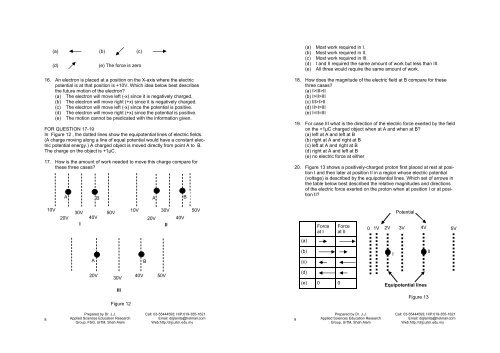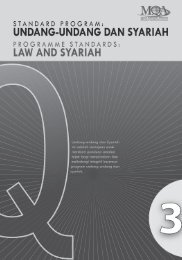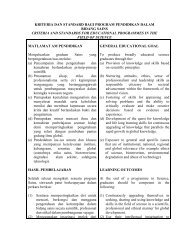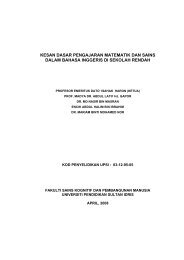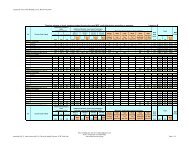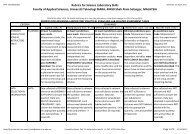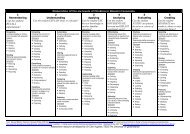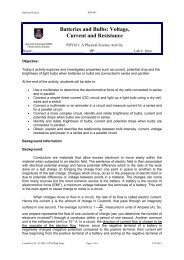Basic Physics II Evidences - DrJJ - UiTM
Basic Physics II Evidences - DrJJ - UiTM
Basic Physics II Evidences - DrJJ - UiTM
You also want an ePaper? Increase the reach of your titles
YUMPU automatically turns print PDFs into web optimized ePapers that Google loves.
(a) (b) (c)(d)(e) The force is zero16. An electron is placed at a position on the X-axis where the electricpotential is at that position is +10V. Which idea below best describesthe future motion of the electron?(a) The electron will move left (-x) since it is negatively charged.(b) The electron will move right (+x) since it is negatively charged.(c) The electron will move left (-x) since the potential is positive.(d) The electron will move right (+x) since the potential is positive.(e) The motion cannot be predicated with the information given.FOR QUESTION 17-19In Figure 12 , the dotted lines show the equipotential lines of electric fields.(A charge moving along a line of equal potential would have a constant electricpotential energy.) A charged object is moved directly from point A to B.The charge on the object is +1µC.17. How is the amount of work needed to move this charge compare forthese three cases?ABAB(a) Most work required in I.(b) Most work required in <strong>II</strong>.(c) Most work required in <strong>II</strong>I.(d) I and <strong>II</strong> required the same amount of work but less than <strong>II</strong>I.(e) All three would require the same amount of work.18. How does the magnitude of the electric field at B compare for thesethree cases?(a) I><strong>II</strong>I><strong>II</strong>(b) I><strong>II</strong>><strong>II</strong>I(c) <strong>II</strong>I>I><strong>II</strong>(d) <strong>II</strong>>I><strong>II</strong>I(e) I=<strong>II</strong>=<strong>II</strong>I19. For case <strong>II</strong>I what is the direction of the electric force exerted by the fieldon the +1µC charged object when at A and when at B?(a) left at A and left at B(b) right at A and right at B(c) left at A and right at B(d) right at A and left at B(e) no electric force at either20. Figure 13 shows a positively-charged proton first placed at rest at positionI and then later at position <strong>II</strong> in a region whose electric potential(voltage) is described by the equipotential lines. Which set of arrows inthe table below best described the relative magnitudes and directionsof the electric force exerted on the proton when at position I or at position<strong>II</strong>?10V20V30VI40V50V10V20V30V<strong>II</strong>40V50VForceat IForceat <strong>II</strong>01V2VPotential3V4V5V(a)AB(b)(c)<strong>II</strong>I20V30V<strong>II</strong>IFigure 1240V50V(d)(e) 0 0Equipotential linesFigure 138Prepared by Dr. J.J.Applied Sciences Education ResearchGroup, FSG, <strong>UiTM</strong>, Shah AlamCall: 03-55444593; H/P:019-355-1621Email: drjjlanita@hotmail.comWeb:http:/drjj.uitm.edu.my9Prepared by Dr. J.J.Applied Sciences Education ResearchGroup, <strong>UiTM</strong>, Shah AlamCall: 03-55444593; H/P:019-355-1621Email: drjjlanita@hotmail.comWeb:http://drjj.uitm.edu.my


